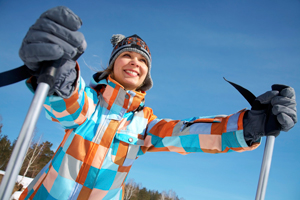Downhill skiing has its ups and downs. Falling on an outstretched hand that’s out in front or to the side of you can cause your hand to spread and your thumb to get caught in the snow. The force can cause the thumb joint to move or bend sideways enough to sprain or even tear the ligament.
 A sprain or tear to the ulnar collateral ligament (UCL) of the thumb can generate sharp pain on the inside of thumb where it meets the palm. Because grasping with the thumb is a major function of the hand, injury to the UCL can render you unable to hold onto things such as a water bottle. A tear can make the thumb unstable and cause it to bend sideways.
A sprain or tear to the ulnar collateral ligament (UCL) of the thumb can generate sharp pain on the inside of thumb where it meets the palm. Because grasping with the thumb is a major function of the hand, injury to the UCL can render you unable to hold onto things such as a water bottle. A tear can make the thumb unstable and cause it to bend sideways.
If you injure your thumb during a fall while skiing or doing another activity, a medical exam of the injury is recommended. Your doctor will move the thumb to test the stability of the thumb joint. An X-ray usually is necessary to confirm the severity of the injury.
For a thumb sprain, treatment may include:
- Protection - use a splint to stabilize.
- Rest – limit activity to prevent aggravation.
- Ice - use ice cubes in a plastic bag for 10-15 minutes to limit bleeding, swelling and decrease pain.
- Compression – use a narrow elastic wrap or splint to gently support the injury.
- Elevation – raise the injury above the heart to limit swelling.
When the UCL is completely torn, the injury won’t heal. Surgery may be necessary to restore the grasping function of the thumb.
Falls from any activity can cause many injuries. To prevent falls while downhill skiing:
- Gradually develop your skill before skiing more challenging slopes. Get qualified ski instruction that gives you tips on how to control your skis and limit falls. Some instructors will even teach you how to fall to prevent injuries.
- Choose poles that have finger grooves instead of wrist straps. If your poles have straps, check with the equipment manufacturer’s instructions for the pole strap placement and adjustment. There is a right way and a wrong way to wear the straps. Proper strap placement limits fatigue and doesn’t block normal motion.
- Let go of your poles when you fall.
- Hold your hand in a fist and try to roll rather than plop. An outstretched hand with the fingers and thumb spread is more likely to get caught in the snow and forced into unnatural motions.
Share comments or questions on this information email: sports.medicine@marshfieldclinic.org.
